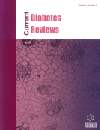- Home
- A-Z Publications
- Current Diabetes Reviews
- Previous Issues
- Volume 1, Issue 2, 2005
Current Diabetes Reviews - Volume 1, Issue 2, 2005
Volume 1, Issue 2, 2005
-
-
Cardiovascular Disease Risk of Type 2 Diabetes Mellitus and Metabolic Syndrome: Focus on Aggressive Management of Dyslipidemia
More LessAuthors: James M. Falko, Robert J. Moser, Sophia B. Meis and Teresa Caulin-GlaserType 2 diabetes mellitus and the closely related metabolic syndrome markedly increase the risk of cardiovascular disease a major contributor is the dyslipidemia. Recent studies and new national guidelines suggest these very high risk patients with cardiovascular disease achieve optional low density lipoprotein cholesterol (LDL-C) level of less than 70mg/dl. In addition there may be no threshold to begin therapeutic lifestyle cha Read More
-
-
-
The Metabolic Syndrome and Cardiovascular Risk
More LessAuthors: Gang Hu, Qing Qiao and Jaakko TuomilehtoThere are four definitions of the metabolic syndrome that have been recommended by the World Health Organization (WHO), the European Group for Study of Insulin Resistance (EGIR), the National Cholesterol Education Program Expert Panel (NCEP), and the American Association of Clinical Endocrinologists (AACE) separately since 1998. The prevalence of the metabolic syndrome reported from different studies has varied wi Read More
-
-
-
Management of the Metabolic Syndrome as a Strategy for Preventing the Macrovascular Complications of Type 2 Diabetes: Controversial Issues
More LessThe metabolic syndrome is known to increase cardiovascular morbidity and precede the development of type 2 diabetes. Even before the appearance of hyperglycemia, the components of the metabolic syndrome play a crucial role in the pathogenesis of the macrovascular complications. Thus, the recognition and treatment of the metabolic syndrome may be a strategy to prevent the most likely cause of de Read More
-
-
-
Platelet in Progression of Atherosclerosis: A Potential Target in Diabetic Patients
More LessAuthors: Hidenori Koyama and Yoshiki NishizawaAltered platelet function reported in diabetic patients appears to be involved in the pathogenesis of diabetic vascular complications. However until recently, the role of platelets in progression of spontaneous atherosclerosis remained questionable. The original version of the response to injury hypothesis, where deposited platelets at denuded endothelium play key roles in the spontaneous development of atherosclerosis, has be Read More
-
-
-
Molecular Mechanisms of Skeletal Muscle Insulin Resistance in Type 2 Diabetes
More LessAuthors: Karim Bouzakri, Heikki A. Koistinen and Juleen R. ZierathType 2 (non-insulin-dependent) diabetes mellitus afflicts millions of people worldwide and is one of the main causes of morbidity and mortality. Current therapeutic agents to treat Type 2 diabetes are insufficient and thus, newer approaches are desperately needed. Type 2 diabetes is manifested by progressive metabolic impairments in tissues such as skeletal muscle, adipose tissue and liver, such that these tissues be Read More
-
-
-
PGC-1α and Exercise: Important Partners in Combating Insulin Resistance
More LessDiabetes and obesity are characterised by an impairment in mitochondrial function resulting in a decrease in glucose and fatty acid oxidation, respiration and an increase in intramuscular triglycerides (IMTG's) and insulin resistance. Peroxisome proliferator-activated receptor (PPAR)-γ coactivator 1α (PGC-1α) is a nuclear transcriptional coactivator which regulates several important metabolic processes including, mitoch Read More
-
-
-
Down-Regulation of Angiogenic Inhibitors: A Potential Pathogenic Mechanism for Diabetic Complications
More LessAuthors: Jian-xing Ma, Sarah X. Zhang and Joshua J. WangDiabetic retinopathy (DR) and diabetic nephropathy (DN) are the most common microvascular complications of diabetes. DR is a leading cause of blindness, and DN is a major cause of end-stage renal diseases. Diabetic macular edema (DME) resulting from increased vascular permeability in the retina and retinal neovascularization (NV) represent two major pathological changes in DR and are the primary causes of vision loss Read More
-
-
-
Angiotensin II-Induced Signaling Pathways in Diabetes
More LessAuthors: Mario B. Marrero, David Fulton, David Stepp and David M. SternExcessive cellular proliferation is a major contributor to the pathological changes associated with the secondary complications of diabetes. In particular, hyperglycemia (HG)-induced growth of vascular smooth muscle cells (VSMC) and glomerular mesangial cells (GMC) are characteristic features of the cardiovascular and renal complications of diabetes. VSMC and GMC respond to traditional growth factors, however in dia Read More
-
-
-
Gestational Diabetes Mellitus: A Review from 2004
More LessGestational diabetes mellitus (GDM) is carbohydrate intolerance with onset or first recognition in pregnancy. More often than not the intolerance abates between pregnancies but may recur. As well, up to 70% of affected women will manifest type 2 diabetes mellitus within 10 years thereafter. GDM is diagnosed with a glucose challenge at approximately 28 weeks' gestation though there is no universally accepted protocol for th Read More
-
-
-
Basal Bolus Dosing: A Clinical Experience
More LessAuthors: Allen B. King and Dana U. ArmstrongBasal bolus insulin dosing (BBD) may be defined as the physiological replacement of basal and bolus insulin to achieve near normal glycemia without hypoglycemia and loss of life quality. Normally, continuous and variable basal insulin release provides partial suppression of hepatic glucose production to maintain euglycemia during the fasting period. With meals, additional insulin is released in a biphasic pattern to further su Read More
-
Volumes & issues
-
Volume 21 (2025)
-
Volume 20 (2024)
-
Volume 19 (2023)
-
Volume 18 (2022)
-
Volume 17 (2021)
-
Volume 16 (2020)
-
Volume 15 (2019)
-
Volume 14 (2018)
-
Volume 13 (2017)
-
Volume 12 (2016)
-
Volume 11 (2015)
-
Volume 10 (2014)
-
Volume 9 (2013)
-
Volume 8 (2012)
-
Volume 7 (2011)
-
Volume 6 (2010)
-
Volume 5 (2009)
-
Volume 4 (2008)
-
Volume 3 (2007)
-
Volume 2 (2006)
-
Volume 1 (2005)
Most Read This Month
Article
content/journals/cdr
Journal
10
5
false
en


